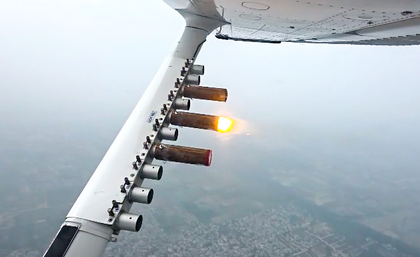IIT Kanpur Director explains why cloud seeding didn’t cause rain in Delhi; another attempt planned today
By IANS | Updated: October 29, 2025 11:25 IST2025-10-29T11:20:58+5:302025-10-29T11:25:08+5:30
New Delhi, Oct 29 The much-anticipated attempt to induce artificial rain through cloud seeding over parts of Delhi ...

IIT Kanpur Director explains why cloud seeding didn’t cause rain in Delhi; another attempt planned today
New Delhi, Oct 29 The much-anticipated attempt to induce artificial rain through cloud seeding over parts of Delhi turned out to be “not completely successful.” According to IIT Kanpur Director Manindra Agrawal, the failure was largely due to insufficient moisture in the clouds, emphasising that cloud seeding is not a magic bullet for Delhi’s pollution crisis but rather an emergency, last-resort measure. He also stated that the team plans to make fresh attempts on Wednesday
Speaking exclusively to NDTV on Tuesday, Agrawal, whose institute is collaborating with the Delhi government for this experimental project said that the team plans to make fresh attempts on Wednesday, expressing hope for improved results.
“There hasn’t been any rain so far. So, in that sense, it was not completely successful. Unfortunately, the clouds present today did not have very high moisture content. I am told it was only around 15–20 per cent. The possibility of inducing rain with such low moisture levels is not very high. But this trial has given more confidence to our team to continue conducting them,” Agrawal told NDTV.
The IIT Kanpur-led team used a mixture comprising 20 per cent silver iodide and the rest made up of rock salt and common salt to seed the clouds. On Tuesday, 14 flares were fired in total.
“There were conflicting reports about the likelihood of rain today. Some forecasts predicted rain, while others did not. But our own observation was that the cloud cover had very low moisture content — and this could well be true for the entire region we flew over. So, we do not expect rain today,” Agrawal added.
Two additional flights, he said, are scheduled for Wednesday, and the operations will continue whenever suitable cloud cover is available.
When asked whether cloud seeding could serve as a long-term remedy for Delhi’s persistent air pollution, Agrawal was clear in his response.
“It is an SOS solution, something to attempt only in a crisis when pollution levels are extremely high. It is not a permanent solution. The permanent solution, of course, is to control the sources of pollution. Ideally, we should reach a stage where there’s no need for cloud seeding because pollution itself has been eliminated. Until then, this is one of the tools available to provide temporary relief,” he said.
Agrawal acknowledged that the current cost of the operations is high because the flights are being conducted from Uttar Pradesh. However, he added that these costs could be reduced substantially in future attempts.
“Any effort that leads to even a partial reduction in pollution benefits everyone. Even if rain comes after a few days, it can still provide some relief,” he added.
According to a preliminary report by the Delhi government, the cloud seeding experiment did help reduce particulate matter levels in some of the targeted areas. Two minor precipitation events were recorded 0.1 mm of rain in Noida and 0.2 mm in Greater Noida around 4 p.m. on Tuesday.
Before seeding, the PM 2.5 levels were recorded at 221 (Mayur Vihar), 230 (Karol Bagh), and 229 (Burari). After seeding, they dropped to 207, 206, and 203 respectively.
Similarly, PM 10 levels fell from 207, 206, and 209 to 177, 163, and 177 in the same areas.
Delhi’s Forest and Environment Minister Manjinder Singh Sirsa had confirmed that two cloud seeding attempts were made on Tuesday — one in the morning and another in the evening — with assistance from IIT Kanpur.
“Today, one attempt was made in the morning and another in the evening. The results are still being collated,” Sirsa told IANS, emphasising that the Delhi government is committed to exploring scientific solutions to combat the city’s toxic air.
The experiment comes at a time when Delhi’s air quality has sharply deteriorated in the days following Diwali celebrations. The Air Quality Index (AQI) across Delhi and the National Capital Region (NCR) has remained in the “poor” to “very poor” category, with smog blanketing large parts of the city.
Cloud seeding involves dispersing substances like silver iodide nanoparticles, iodized salt, and dry ice into the atmosphere to stimulate cloud condensation and trigger rainfall. It is often used in regions suffering from water scarcity, or to reduce hail and fog.
On Tuesday, IIT Kanpur’s aircraft seeded a corridor approximately 25 nautical miles (46.3 km) long and four nautical miles (7.4 km) wide, covering areas between Khekra and Burari colonies.
The first flight released six flares at an altitude of around 4,000 feet, while the second, which took off at 3:55 p.m., deployed eight flares at a slightly higher altitude of 5,000 feet.
Despite the lack of rainfall, experts consider the trial a significant technical success, marking one of India’s most advanced urban cloud seeding operations to date.
Disclaimer: This post has been auto-published from an agency feed without any modifications to the text and has not been reviewed by an editor
Open in app